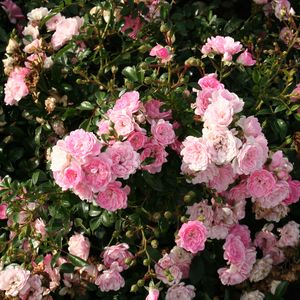 I love all kinds of roses and have as many in my garden as I can cram into the limited sunny space. My “favorite” is usually the one in bloom at the moment, though I do have a few that are especially dear to my heart. Rosa ‘The Fairy’ is one of them.
I love all kinds of roses and have as many in my garden as I can cram into the limited sunny space. My “favorite” is usually the one in bloom at the moment, though I do have a few that are especially dear to my heart. Rosa ‘The Fairy’ is one of them.
You have probably seen ‘The Fairy’, as it has enjoyed enduring popularity since it was introduced in England back at the height of the Great Depression in 1932. Everything about the shrub is small. It grows about three feet tall and wide, with arching canes that are home to small leaves and perfect, double pink flowers borne in sprays or clusters. Those blooms average about 1.5 inches wide, opening with soft pink petals that age to nearly white. The owner of a historic house in my neighborhood uses ‘The Fairy’ as a low hedge and it is gorgeous throughout the season, sporting flushes of new blooms regularly from mid-spring through late fall. In my garden, it is untroubled by those two rose maladies, black spot and powdery mildew, which is a bonus, since some of my other roses are not so lucky.
Every rose variety has a unique story, and ‘The Fairy’s is fascinating. It is grouped into a class of roses called “polyanthas”, which comes from Latin and means “many flowers’. These roses are characterized by a compact growth habit and clusters of the blooms. The polyanthas have a long history. Their most notable ancestor is probably Rosa multiflora, a white-flowered species rose native to Japan. These days, we see it everywhere, because it has become a naturalized invasive pest in American woodlands, untenanted places and even the odd spot in home gardens. I have rooted it out of my own beds twice this year alone.
The flip side of the multiflora rose’s extremely vigorous nature is that the vigor has carried over to roses like ‘The Fairy’ that are descended from it. One of ‘The Fairy’s parent roses was ‘Paul Crampel’, an orange-flowered polyantha that was discovered in the Netherlands in 1930. ‘Paul Crampel’, in turn, was a sport, or spontaneous genetic mutation of ‘Superb’, a red-flowered polyantha of unknown parentage, bred in the Netherlands sometime before 1927. How did the offspring of red and orange-red varieties turn up with pale pink flowers? Blame it on the way the genetic soup responds when stirred vigorously by breeders, or possibly on its other parent, a cluster-flowered rose called ‘Lady Gay’, which is described as having cherry-red flowers aging to blush.
The breeder responsible for ‘The Fairy’ was Anne Bentall, the widow of another breeder, Joseph Bentall. Prior to starting his own nursery, Joseph Bentall had been a gardener for Anglican cleric and prolific rose breeder, Joseph Pemberton. I have several of Pemberton’s best roses, all in the fragrant, hybrid musk category, in my garden. The Pemberton roses also have Rosa multiflora in their family trees. Clearly both Pemberton and Bentall thought highly of Rosa multiflora as a breeding subject.
‘The Fairy’ made its way to America and was introduced here in 1941. Since then it has blazed a trail through gardens here and all over the world, loved for its hardiness, prolific repeat-blooming habit and overall beauty. These days, when smaller landscapes and container gardens have become important, ‘The Fairy’ continues its hot streak. The shrub has won all kinds of awards and accolades, including the Royal Horticultural Society’s “Award of Garden Merit” and the “Earth Kind” designation from the Texas AgriLife Extension Service of Texas A&M University. The Earth Kind roses have undergone extensive trials under all kinds of climate conditions and proven themselves to be of outstanding landscape value. Longwood Gardens, in Kennett Square, Pennsylvania, also subjected ‘The Fairy’ to its own ten-year rose trial. Needless to say, it came out of the Pennsylvania test smelling like a rose.
Most roses need lots of sun—about six hours of direct sunlight per day. Most gardeners I know wish they had more sunny space for roses, tomatoes and all the other plants that require a good dose of sunshine to flourish. Fortunately for all of us, ‘The Fairy’ can get by with a little less and can even tolerate very light shade. It is also relatively unfussy about soil and once it is established, can survive some dry periods. Aphids may climb aboard and attempt to suck vital fluids out of the buds, but they are easily dispatched with a spray from the garden hose.
For economically minded gardeners, ‘The Fairy’ is an especially good investment. Use it as a low boundary hedge or to flank a walkway. It can also be a mid-border subject, or the star of a large container. In my experience the flowers last very well in cut arrangements and the plant will immediately start the process of replacing the sprays that you clip off. Deadheading also promotes new growth.
Sometimes good nurseries or garden centers carry ‘The Fairy’, though right now it is somewhat late in the season and stocks of roses are generally low. Order it for fall delivery from Chamblee’s Roses, 16807 CR 363
Winona, TX 75792; 903-882-5153; www.chambleeroses.com.
